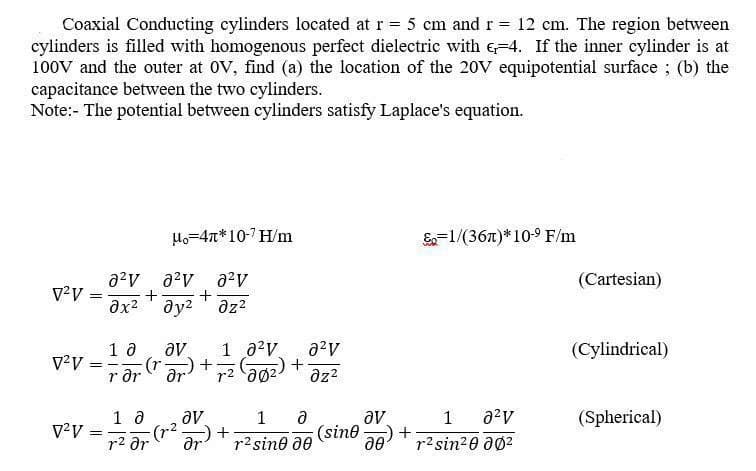Coaxial Conducting cylinders located at r = 5 cm and r = 12 cm. The region between cylinders is filled with homogenous perfect dielectric with 4. If the inner cylinder is at 100V and the outer at OV, find (a) the location of the 20V equipotential surface; (b) the capacitance between the two cylinders. Note: The potential between cylinders satisfy Laplace's equation. V2V= V²V V²V = = a²v a²v 2² v + + дх² дуг дz2 1 ə Mo=4*10-7 H/m - av (r -) 1 0² rər (ar) + √² (20₂) +- 10 r² ar (1² av -) + a²v дz2 ər 1 ə r2sin0 ?0 av (sino) + де & 1/(36)* 10-⁹ F/m 1 0² r² sin²0 20² (Cartesian) (Cylindrical) (Spherical)
Coaxial Conducting cylinders located at r = 5 cm and r = 12 cm. The region between cylinders is filled with homogenous perfect dielectric with 4. If the inner cylinder is at 100V and the outer at OV, find (a) the location of the 20V equipotential surface; (b) the capacitance between the two cylinders. Note: The potential between cylinders satisfy Laplace's equation. V2V= V²V V²V = = a²v a²v 2² v + + дх² дуг дz2 1 ə Mo=4*10-7 H/m - av (r -) 1 0² rər (ar) + √² (20₂) +- 10 r² ar (1² av -) + a²v дz2 ər 1 ə r2sin0 ?0 av (sino) + де & 1/(36)* 10-⁹ F/m 1 0² r² sin²0 20² (Cartesian) (Cylindrical) (Spherical)
Introductory Circuit Analysis (13th Edition)
13th Edition
ISBN:9780133923605
Author:Robert L. Boylestad
Publisher:Robert L. Boylestad
Chapter1: Introduction
Section: Chapter Questions
Problem 1P: Visit your local library (at school or home) and describe the extent to which it provides literature...
Related questions
Question
Find the location of the 20V equipotential surface and the capacitance between cylinders satisfy laplace's equation

Transcribed Image Text:Coaxial Conducting cylinders located at r = 5 cm and r = 12 cm. The region between
cylinders is filled with homogenous perfect dielectric with 4. If the inner cylinder is at
100V and the outer at OV, find (a) the location of the 20V equipotential surface; (b) the
capacitance between the two cylinders.
Note:- The potential between cylinders satisfy Laplace's equation.
V²V
V²V
=
² ² 8²V
+ +
дх2 дуг дz2
10
rər
==
Mo=47*107H/m
av
(r. ər) +
10 av
др
V²V = √² Fr
1 0²
2²v
r²0² + az²
(202)
(r.²
+
1 Ə
r² sine de
(sine
av
o
=1/(36)*10-⁹ F/m
1 a²v
+r²sin²0 ز
(Cartesian)
(Cylindrical)
(Spherical)
Expert Solution
This question has been solved!
Explore an expertly crafted, step-by-step solution for a thorough understanding of key concepts.
This is a popular solution!
Trending now
This is a popular solution!
Step by step
Solved in 3 steps with 3 images

Knowledge Booster
Learn more about
Need a deep-dive on the concept behind this application? Look no further. Learn more about this topic, electrical-engineering and related others by exploring similar questions and additional content below.Recommended textbooks for you

Introductory Circuit Analysis (13th Edition)
Electrical Engineering
ISBN:
9780133923605
Author:
Robert L. Boylestad
Publisher:
PEARSON

Delmar's Standard Textbook Of Electricity
Electrical Engineering
ISBN:
9781337900348
Author:
Stephen L. Herman
Publisher:
Cengage Learning

Programmable Logic Controllers
Electrical Engineering
ISBN:
9780073373843
Author:
Frank D. Petruzella
Publisher:
McGraw-Hill Education

Introductory Circuit Analysis (13th Edition)
Electrical Engineering
ISBN:
9780133923605
Author:
Robert L. Boylestad
Publisher:
PEARSON

Delmar's Standard Textbook Of Electricity
Electrical Engineering
ISBN:
9781337900348
Author:
Stephen L. Herman
Publisher:
Cengage Learning

Programmable Logic Controllers
Electrical Engineering
ISBN:
9780073373843
Author:
Frank D. Petruzella
Publisher:
McGraw-Hill Education

Fundamentals of Electric Circuits
Electrical Engineering
ISBN:
9780078028229
Author:
Charles K Alexander, Matthew Sadiku
Publisher:
McGraw-Hill Education

Electric Circuits. (11th Edition)
Electrical Engineering
ISBN:
9780134746968
Author:
James W. Nilsson, Susan Riedel
Publisher:
PEARSON

Engineering Electromagnetics
Electrical Engineering
ISBN:
9780078028151
Author:
Hayt, William H. (william Hart), Jr, BUCK, John A.
Publisher:
Mcgraw-hill Education,